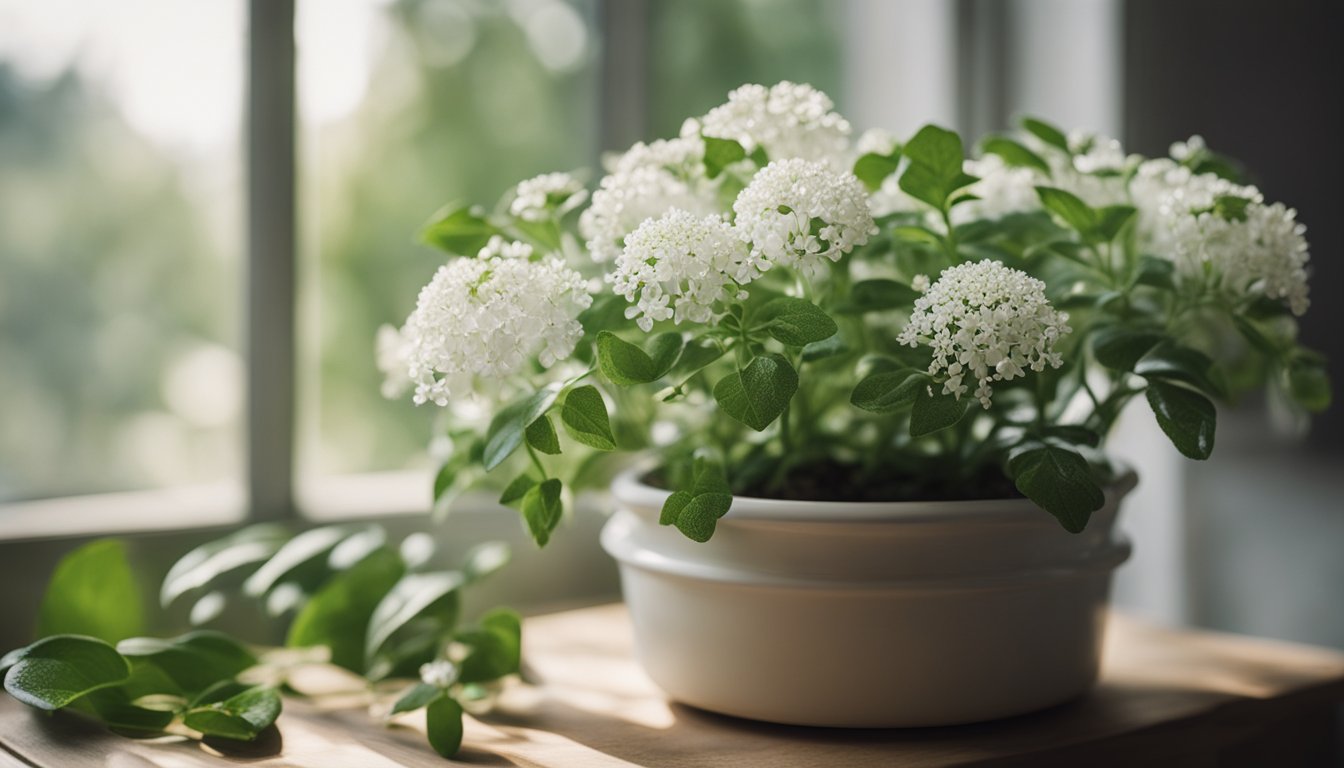If you’re looking to add a touch of elegance to your home, the bridal veil plant is a stunning choice. With its delicate, cascading foliage and charming white flowers, this plant not only beautifies any space but also brings a sense of tranquillity. Imagine a lush green cascade that softens corners and brightens up your living area.
Caring for a bridal veil plant is surprisingly easy, making it perfect for both seasoned plant lovers and beginners. Whether you place it on a shelf or let it hang in a pot, its graceful tendrils will create a captivating atmosphere. Ready to transform your home with this enchanting plant? Let’s dive into everything you need to know about the bridal veil plant and how to make it thrive in your space.
Overview of Bridal Veil Plant
The bridal veil plant, known scientifically as Gynura froebelii, boasts lush green leaves and cascading stems. This beauty adds a touch of elegance to any space. The delicate white flowers often appear, creating a stunning contrast against the vibrant foliage.
I find this plant thrives indoors, basking in bright, indirect light. It enjoys humidity and grows well in warm environments. Having a bridal veil plant means I need to keep the soil slightly moist, but not soggy, to prevent root rot. This plant doesn’t ask for much, just a little love and attention.
Caring for the bridal veil plant is simple. I gently wipe its leaves to keep dust at bay. Fertilizing once a month during the growing season provides a boost, helping it flourish. If I spot any pests, tackling them promptly ensures the plant stays healthy and vibrant.
One fun tip: I often propagate cuttings in water. Watching roots develop is exciting and rewarding. Before I know it, I’ve created new plants to share with friends and family.
Overall, the bridal veil plant enhances my home with its beauty and charm while being easy to care for. It’s no wonder many people choose this delightful plant as part of their decor.
Characteristics of Bridal Veil Plant

The bridal veil plant boasts unique features that charm plant lovers. Its beauty shines in both appearance and care requirements.
Appearance and Growth Habits
I admire the bridal veil plant for its striking appearance. The lush, green leaves create a vibrant display while cascading stems add movement. Sometimes, it looks like a waterfall of greenery. This plant can reach heights of 1 to 2 feet, depending on its care and environment. White flowers appear in clusters, adding elegance. Growth habits are vigorous, making it a lovely choice for hanging pots and shelves. It resembles a delicate veil flowing gracefully, which is how it got its name.
Soil and Light Requirements
Bridal veil plants flourish in specific conditions. They thrive in well-draining potting soil. A mix designed for indoor plants works well. Bright, indirect light is ideal, as direct sunlight can scorch the leaves. I keep mine near a window that filters light softly. Humidity also plays a vital role. This plant enjoys a humid environment. Spraying water on the leaves or using a humidity tray can keep it happy. Following these simple guidelines promotes healthy growth and vibrant foliage.
Care and Maintenance
Caring for the bridal veil plant ensures it thrives and adds beauty to my space. Following a few simple guidelines keeps it healthy and vibrant.
Watering and Fertilization
Watering the bridal veil plant requires attention, but it’s not complicated. I aim for slightly moist soil without letting it become soggy. Watering when the top inch of the soil feels dry works well. During the growing season, fertilizing once a month with a balanced liquid fertilizer fosters growth. Just remember, too much fertilizer can cause more harm than good. A little goes a long way!
Propagation of Bridal Veil Plant

Propagation of the bridal veil plant is simple and rewarding. I often find joy in watching new growth emerge from cuttings.
Methods of Propagation
I usually propagate bridal veil plants through cuttings. First, I choose a healthy stem with leaves. Next, I cut about 4 to 6 inches from the tip. After that, I place the cutting in water, ensuring at least a couple of leaves stay above the waterline. Fresh roots sprout within a few weeks. When the roots reach about 2 inches, I plant them in well-draining soil. For a faster method, I sometimes use direct soil propagation. I just stick the cutting directly into moist potting soil. I always keep the soil damp, and roots form within a few weeks.
Ideal Conditions for Growth
The bridal veil plant loves warmth and humidity. I make sure to keep my cuttings in a warm spot. A bright, indirect light area works best for growth. I also mist the leaves periodically to boost humidity, creating a cosy environment. If I notice any drooping, I adjust the light or humidity. That often does the trick, encouraging robust growth. Keeping an eye on my cuttings lets me enjoy the delightful process of propagation.
Common Issues and Solutions
Bridal veil plants can face a few common problems. Identifying and addressing these issues early keeps the plant healthy and vibrant.
1. Yellowing Leaves
Yellowing leaves typically indicate overwatering. I check the soil moisture before watering to ensure it isn’t soggy. If I suspect root rot, I remove the plant from the pot and inspect the roots. Healthy roots look firm and white. Any brown, mushy roots must be trimmed.
2. Dropping Leaves
Leaf drop often results from sudden temperature changes or lack of humidity. I keep the plant in stable conditions and ensure humidity remains high. Misting the leaves or placing a humidity tray beneath the plant helps.
3. Pest Infestations
Common pests like spider mites and aphids can attack my bridal veil plant. I inspect the leaves regularly for signs of pests. If I find any, I gently wash the plant with soap and water or use an organic pesticide.
4. Leggy Growth
Leggy growth occurs often when the plant doesn’t receive enough light. I reposition the plant to a brighter location, ensuring it gets bright, indirect light. Pinching back leggy stems encourages bushier growth and gives the plant a fuller appearance.
5. Root Bound Issues
If the plant outgrows its pot, it might become root-bound. I check the drainage holes for roots peeking out. When I notice this, it’s time to repot into a larger container with fresh potting soil.
Keeping these common issues in mind ensures my bridal veil plant thrives. Every small adjustment makes a difference in maintaining its beauty and health.
Before You Go – Bridal Veil Plant Care
The bridal veil plant truly stands out as a stunning addition to any home. Its graceful appearance and easy care make it a favorite among plant lovers. I’ve enjoyed watching it thrive in my space and appreciate how it brings a touch of nature indoors.
With a little attention to light and humidity, this plant rewards you with lush foliage and beautiful blooms. Whether you’re a seasoned gardener or just starting, the bridal veil plant offers a delightful experience that’s both satisfying and rewarding. Give it a try and watch your living space transform into a serene oasis. Don’t forget to add The Herb Prof to your favorites so you don’t miss out on future articles.
References – Bridal Veil Plant Care
Little Herb Encyclopedia, by Jack Ritchason; N.D., Woodland Publishing Incorporated, 1995
The Ultimate Healing System, Course Manual, Copyright 1985, Don Lepore
Planetary Herbology, Michael Tierra, C.A., N.D., Lotus Press, 1988
Handbook of Medicinal Herbs, by James A. Duke, Pub. CRP Second Edition 2007
The Complete Medicinal Herbal, by Penelope Ody, Published by Dorling Kindersley
Check the Following Articles
Benefits of Growing Perennial Vegetables For Your Garden
Strategies for Effective Protection of Crops
The Beauty and Benefits of Milkweed Pods
How to Harvest Cilantro: Tips for Fresh and Flavorful Leaves
Frequently Asked Questions – Bridal Veil Plant Care
1. What is a bridal veil plant?
The bridal veil plant, or Gynura froebelii, is a decorative houseplant known for its lush green leaves, cascading stems, and charming white flowers. It brings a touch of elegance and tranquillity to indoor spaces and is suitable for both beginner and experienced plant enthusiasts.
2. How do I care for a bridal veil plant?
To care for a bridal veil plant, place it in bright, indirect light and keep the soil slightly moist, watering when the top inch feels dry. Maintain humidity by misting the leaves or using a humidity tray, and fertilize monthly during the growing season.
3. What type of light does the bridal veil plant need?
The bridal veil plant thrives in bright, indirect light. Avoid direct sunlight, as it can scorch the leaves and negatively affect the plant’s health.
4. How often should I water my bridal veil plant?
Water your bridal veil plant when the top inch of the soil feels dry. Ensure the soil remains slightly moist but not soggy to prevent root rot.
5. Can I propagate a bridal veil plant?
Yes, you can easily propagate a bridal veil plant using cuttings. Take a healthy stem cutting, place it in water or moist potting soil, and keep it in bright, indirect light with adequate humidity for best results.
6. What are common issues with bridal veil plants?
Common issues include yellowing or dropping leaves, leggy growth, and pest infestations. To address these, monitor soil moisture, maintain humidity, inspect for pests, and ensure proper light and repotting when necessary.
7. How tall does a bridal veil plant grow?
A bridal veil plant can reach heights of 1 to 2 feet. Its vigorous growth makes it an excellent choice for hanging pots and shelves, giving a delicate, cascading effect.

